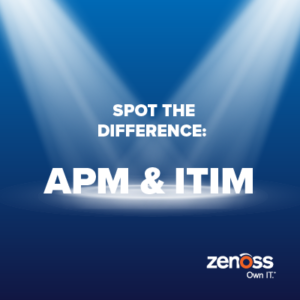
What you do know is that you need to understand if an IT service is available, how it’s performing, and whether users are having a smooth experience. You need to know when website users experience an outage or slow response, and, ideally, you need to find ways to prevent issues from happening in the first place.
So, what’s the difference between the two? How can APM and ITIM help you get to this state of enlightenment?
What the Tools Actually Do
APM focuses on the overall performance of an application from the perspective of the end user and follows their experience as they perform transactions with a given IT service, such as a checkout function on a shopping site. APM also monitors the calls made by the application to supporting operating systems and databases. Instrumenting applications can be quite expensive, so it is often applied only to the most business-critical applications and services.
ITIM, on the other hand, monitors persistent and ephemeral elements in an IT environment. Zenoss, in particular, monitors a wide breadth of IT infrastructure spanning virtual, cloud, converged, and physical environments. This includes storage, networking and compute resources as well as databases, containers and much more. As today’s environments are quite dynamic, the best ITIM tools have a deep understanding of the infrastructure elements and track their interrelationships and dependencies in real time. The best platforms take it a step further and map how each individual resource supports business-critical services, like those monitored by APM. Also, ITIM can be agentless, which further reduces overhead, meaning you can instrument more of your environment with less fuss.
This seems simple but is further complicated by vendors from one of these buckets spreading into the other. A number of APM vendors have started to talk about ITIM capabilities and acquisitions they’ve done in this space, and vice versa. However, they tend to lack the depth and breadth of their counterparts.
What Insights You Can Get
This is where it gets interesting. Let’s break it down together.
Here are some things that an APM tool can tell you:
- Are affected users in a certain regional ISP or across all geographies?
- Is the entire transaction flow affected or just specific steps?
- Is there a bug in the application code that is causing issues?
- Is the end-user experience acceptable? Are they experiencing a slowed service?
Here’s what an ITIM platform like Zenoss can tell you:
- Is an application at risk but not yet impacted? (For example, a backup server may be down, which will affect users when a website attains peak usage and all of the servers kick in.)
- Which services are affected by an infrastructure issue?
- What is the most likely root cause of a service outage?
An example of what both will let you know: Is the website URL available?
Now that you have an idea of what these tools will tell you, what does this all mean? Well, it’s important to understand the limitations. An APM tool tends to have limited understanding of the underlying infrastructure of an application — say, 10-15 percent, or about the amount of an iceberg that actually peeks out above the water line. Because of this, it will not detect a threat to an application caused by an infrastructure disruption if the user has not yet been affected. APM will not pinpoint the root of an infrastructure issue causing application problems. APM will not detect risks to backup or redundant systems that are not currently participating in transactions.
Unified Monitoring = APM + ITIM + …
So, the moral of this little story is that you really need both APM and ITIM to implement a true service-centric unified monitoring approach. You need to know that your users are being served well by your applications, pinpoint the root cause of any outage, and get early warnings for issues that affect key services.
Learn more about how Zenoss can solve your IT and monitoring challenges. Attend our GalaxZ event this June!







